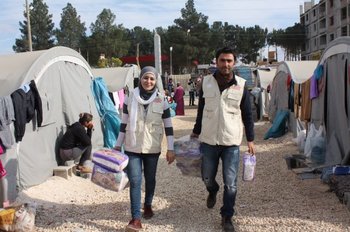NGOs have been drastically affected by COVID-19, and some are struggling to cover core expenses for the coming years.
The problem is accentuated for local NGOs already struggling with funding, primarily due to donors prioritising projects responding to the COVID-19 pandemic as needs mount.
Back in 2015, I was leading the programme department of a local NGO in Turkey working on the Syria response. With the majority of our team based in the field, using Skype and other teleconferencing tools was the only way to collaborate, have meetings and manage projects, years before the COVID-19 pandemic made it routine in many people’s working lives.
The organisation was struggling with funding, as donors were retracting from current projects and not funding new ones. We had to come up with a strategy to adapt to the new funding opportunities and minimise the reliance on indirect funds to keep the organisation afloat.

Today, COVID-19 is posing similar challenges as NGOs are at risk due to the funding crisis despite their instrumental role in responding to the pandemic.
Since April 2020, I’ve been consulting and collaborating with NGOs to refine and adapt this strategy to respond to fears of declining funds due to COVID-19.
We’ve collectively identified 4 key steps as a generic strategic response plan.
1. Analyse the impact of COVID-19
COVID-19 has impacted NGOs in one way or the other, and conducting an analysis of the current financial situation is helpful to identify areas of biggest impact and create a baseline for future measuring.
Unfortunately, most NGOs still rely on rudimentary tools to monitor expenditure and savings. The reports are time-consuming to prepare (especially using Excel) and difficult to read and share, rendering them outdated. While working on the Syria response, our teams were spread out in three different countries, which is why we had to depend on tools that allow remote collaboration.

During COVID-19, I’ve started relying more on dashboards to simplify the expenditure monitoring and sharing process.
Dashboards simplify financial data and allow advanced and real-time analysis, especially for non-financial and management staff, informing their timely and corrective strategic decisions. Dashboards can also help elucidate the analysis of operational costs – such as office rent, communication and insurance, etc. – which are typically prioritised as they may not be entirely covered by donors, putting a lot of strain on unrestricted funds.
For example, some organisations are taking advantage of closed offices by setting a provisional date for reopening and calculating savings in operational costs such as electricity, maintenance, printing, utilities and other variable costs.
In Syria, we were not utilising our donor budget lines for operational costs, which identified weaknesses in the allocation process that were rectified later. Dashboards also allow easier reallocation of such costs to donor budgets.
2. Invest savings strategically and adapt a bottom-up approach
While working on the Syria response, we utilised some of the savings to invest in research and development to improve our programming and introduce innovation to respond to new challenges similar to those emerging from COVID-19.
We adopted a participatory, evidence-based and bottom-up approach, working closely with teams on the ground to improve our programming framework, as we were not based in-country and our knowledge of the local context was limited. The process had to involve partners and donors to identify and address weaknesses in responding to donor priorities.

Photo credit: Flickr/ECHO/Caroline Gluck
This resulted in a strengthened framework more aligned with the context and reality on the ground as opposed to frameworks developed in HQ. The use of this approach is even more relevant now, given that most projects are managed remotely.
We decided to begin with our best-performing project which was our strength over other NGOs operating in the same area. Later, we decided to invest in new programmes (such as new themes and regions) to take advantage of the opportunities highlighted in our strategy. The same approach can benefit NGOs today.
3. Cost a plan and prepare a forecast
Our strategic plan depended on having enough funds for implementation, so once the plan was drafted, we translated the plan into a budget and spending plan by costing the plan as accurately as possible.
Further, we utilised rolling forecasting to allow continuous planning and assessment based on frequent spending monitoring. Adopting a rolling forecast approach also facilitated the utilisation of savings immediately rather than waiting for the end-of-year reports from the finance department.
4. Fundraise strategically
Having a COVID-19 programming framework doesn’t guarantee new funding on its own but is rather the starting point to fundraise strategically.
Donor market research is a good starting point to identify new funding opportunities. This should go hand-in-hand with regularly checking what donors are funding for similar NGOs. There’s a public dashboard tracking donor COVID-19 funding that might help explore areas they can expand to and which donors to approach.
Funds already committed by donors should be prioritised as they carry a small risk of being cancelled or redirected. Another focus should be responding to donor priorities or meeting them half-way.
"This is a good opportunity for NGOs to improve their programming frameworks and financial management systems."
Building resilience in a period of uncertainty
Donors will struggle to fund all NGOs, which will likely result in them selectively picking the organisations that ensure best delivery and value for money. This is a good opportunity for NGOs to improve their programming frameworks and financial management systems to reflect these funding and operational challenges. Simultaneously, NGOs should strive to explore new funding opportunities and respond to donor priorities by fundraising strategically.
Let’s embrace this challenge as an opportunity. While the pandemic’s impact on the funding climate for NGOs is clear, approaching the crisis as a chance to make the right adaptations should ultimately improve our resilience in an uncertain and rapidly developing environment.